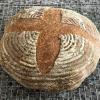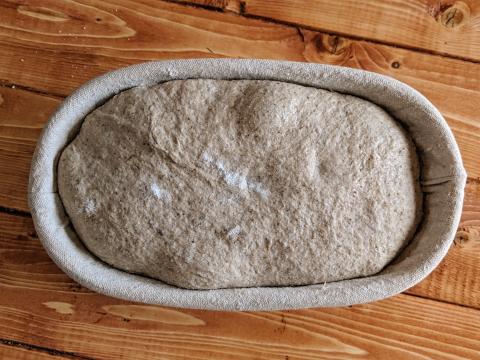
Today's bake 4-25-2019: Multi-grain sourdough with increased Spelt
Sourdough Bread: April 25, 2019
David Snyder
This is basically the same bread I baked on March 22, 2019. The changes are to use whole wheat rather than rye in the starter and to substitute spelt for the rye and some of the all purpose flour in the final dough.
Total Dough |
|
|
Ingredient | Wt (g) | Bakers' % |
High-protein flour | 147 | 13 |
AP flour | 653 | 56 |
Whole Wheat flour | 15 | 1 |
Whole Rye flour | 121 | 10 |
Whole Spelt flour | 234 | 20 |
Water | 769 | 65 |
Salt | 23 | 2 |
Total | 1962 | 147 |
Starter |
|
|
Ingredient | Wt (g) | Bakers' % |
High-protein flour | 110 | 88 |
Whole Wheat flour | 15 | 12 |
Water | 62.5 | 50 |
Firm starter | 62.5 | 50 |
Total | 250 | 200 |
Dissolve the starter in the water.
Add the flours and mix thoroughly.
Ferment at 76ºF for 8-10 hours.
Refrigerate for 12 hours or up to 3 days.
Final Dough |
|
Ingredient | Wt (g) |
AP flour | 653 |
Whole Rye flour | 116 |
Whole Spelt flour | 234 |
Water | 686 |
Salt | 23 |
Starter | 250 |
Total | 1962 |
Procedures
Place the flours and water in the bowl of a stand mixer and mix at low speed to a shaggy mass.
Cover the bowl and let it rest (autolyse) for 1-2 hours.
Sprinkle the salt over the surface of the dough. Add the starter in chunks. Mix at Speed 1 for 2 minutes to distribute ingredients then for about 9 minutes at Speed 2 to develop the dough.
Transfer the dough to a lightly floured board. Shape into a ball.
Transfer the dough to a clean, lightly oiled bowl. Cover the bowl and ferment at 80ºF for about 3 hours with stretch and folds at 50 and 100 minutes.
Divide the dough into two equal pieces. Cover and let rest for 10-30 minutes to relax the gluten.
Shape as boules or bâtards and place in floured bannetons. Cover or place in food-grade plastic bags.
Proof for 2-3 hours at room temperature until the loaves have expanded by about 50%.
Refrigerate for 12-40 hours (The longer the cold retardation, the more sour the final loaf).
Remove from refrigerator. Check on degree of proofing. Proof further at 80ºF, as needed. (May need 1-3 hours.) If adequately proofed, proceed to scoring and baking.
Transfer to a peel. Score as desired.
Bake: If baking in Dutch oven, bake at 475ºF covered for 20 minutes, then uncovered at 450ºF for another 10 minutes or until done to satisfaction.
Bake: If baking on the hearth, pre-heat oven at 500ºF for 1 hour with baking stone and steaming apparatus in place. Turn down oven to 460. Load loaf and steam oven. After 15 minutes, remove steam and continue baking for 20-35 minutes, until loaf is baked. (Depends on size and shape of loaf.)
The bread is done when the crust is nicely colored and the loaf sounds hollow when thumped on the bottom. The internal temperature should be at least 205ºF.
Transfer the bread to a cooling rack and cool thoroughly before slicing.
Today's loaf was cold retarded for 40 hours then proofed at 80ºF for about 80 minutes before being baked. The crust is crunchy. The flavor is lovely – complex with a pronounced acetic acid tang. This is the most sour bread of my current series of experiments. It is rather similar to the March 22 bake. I cannot discern to absence of the rye. Even right after cooling when first tasted, the flavor was well-balanced.

Happy baking!
David

















